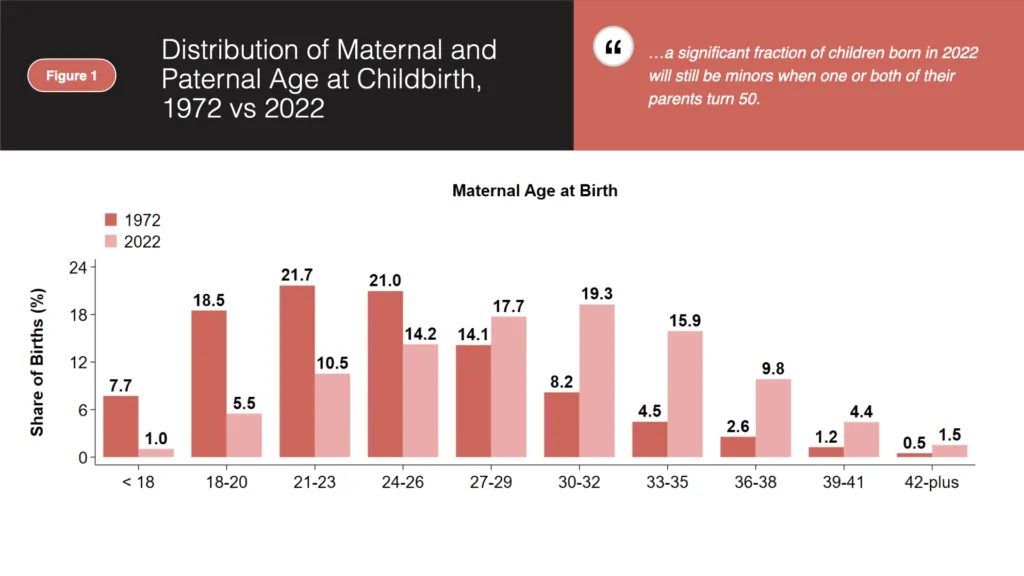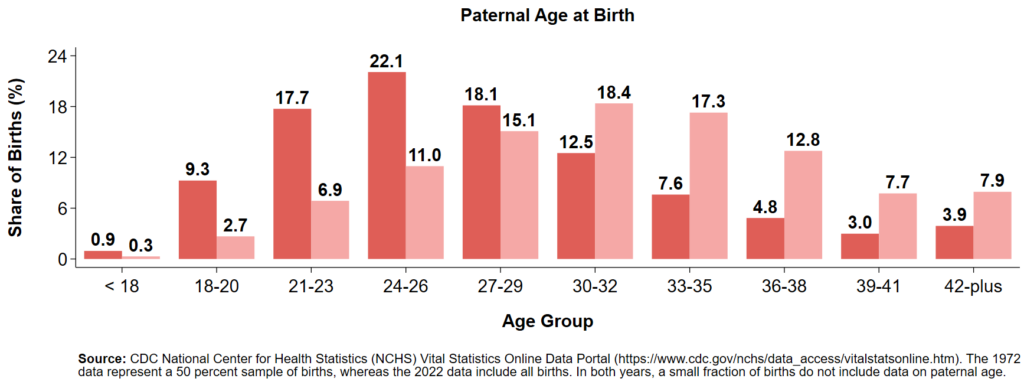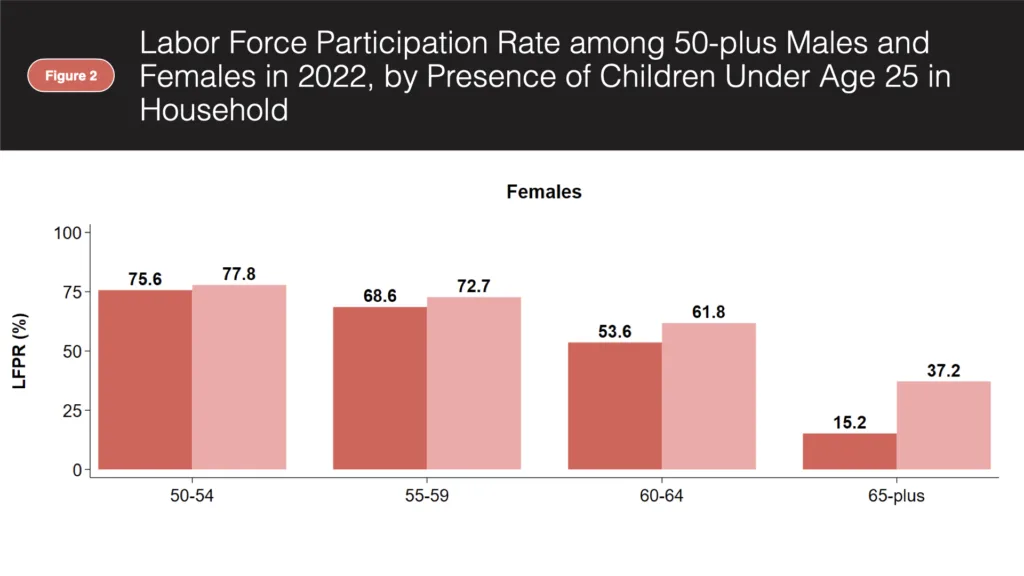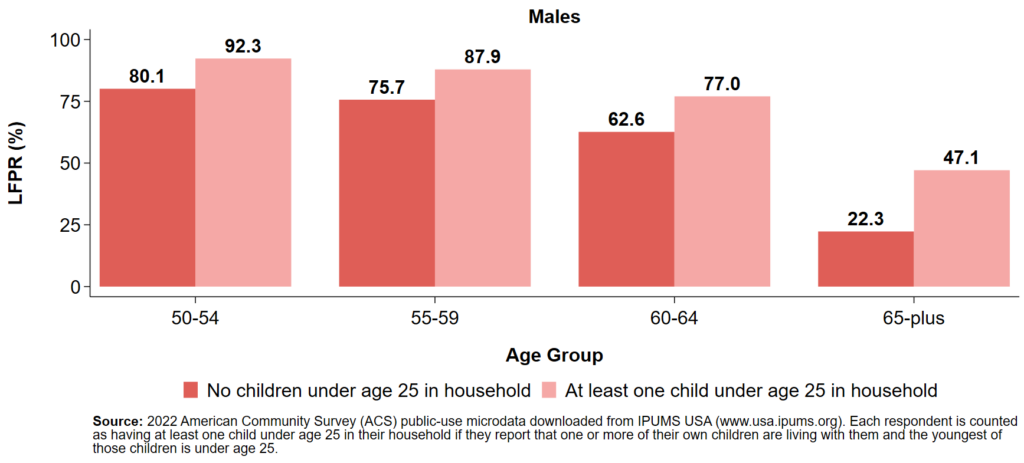Key Takeaways
- Maternal and paternal age at childbirth has risen rapidly for decades, with significant economic and social implications for every generation.
- In 2022, 51 percent of births were to mothers age 30-plus, up from just 17 percent in 1972. Similarly, 64.1 percent of 2022 births were to fathers age 30-plus, up from 31.8 percent in 1972.
- Parents age 50-plus with a child under age 25 in their household are significantly more likely to participate in the labor force relative to adults age 50-plus who do not have a child under age 25 in their household.
- As a rising fraction of people delay their childbearing years, public policies and business practices that combat age discrimination in the workforce will be critical to fostering economic security for every generation.
In addition to deciding whether to have children, choosing when to have them is a critical decision with enormous social and economic implications for parents, their children, and society at large. Over the last 50 years, the distribution of maternal and paternal age at childbirth has evolved from one dominated by people in their teens and twenties to a new normal in which older parents account for an increasingly large fraction of births. This sea change has profound implications for critical economic decisions later in life, including labor supply decisions. The economic success and security of American families depends on recognizing this shift and developing public policies and business practices that meet the needs of all American families.
For many, the concept of “childbearing years” stems from the experience of past generations. In 1972, mothers under age 24 accounted for nearly half (47.9 percent) of all births, whereas mothers age 30-plus were responsible for just 17 percent. Paternal age at childbirth skewed low as well, with fathers age 30-plus yielding fewer than one-third of all births. Children born to parents over age 35 were especially rare, with just 4.3 and 11.7 percent of 1972 births being to mothers and fathers in this age group, respectively. Because their parents had them so early in life, most children born in 1972 reached adulthood before either of their parents turned 50.


Although many still view childbearing as a young person’s pursuit, maternal and paternal ages at childbirth have shifted dramatically over the last 50 years. Mothers under age 24 accounted for just 17 percent of births in 2022, whereas mothers age 30-plus were responsible for over half (51 percent). Similarly, fathers age 30-plus accounted for nearly two-thirds (64.1 percent) of births. One major reason for this shift is the increased representation of mothers and fathers over age 35, who were responsible for 15.8 percent and 28.4 percent of 2022 births, respectively. As a result, a significant fraction of children born in 2022 will still be minors when one or both of their parents turn 50.
Such a dramatic shift in parental age at childbirth has fundamental social and economic implications for parents, their children, and society at large. These ramifications are many and varied; however, one particularly consequential example is that delayed childbearing profoundly affects labor supply decisions later in life. In 2022, females age 50-plus were more likely to participate in the labor force if at least one of their own children under age 25 lived with them, and this disparity rose sharply with age. For those age 65-plus, the labor force participation rate (LFPR) of females with at least one child under age 25 at home (37.2 percent) was more than double that of females without a child under age 25 at home (15.2 percent). The same effect was even more pronounced for males; in fact, males ages 50-54, 55-59, 60-64, and 65-plus with a child under age 25 at home were 12.2, 12.2, 14.4, and 24.8 percentage points more likely to participate in the labor force relative to their counterparts without children under age 25 at home (respectively).1


Although delayed childbearing is associated with economic forces that have generated tremendous benefits for parents and their children, 2 parenting later in life does present challenges, especially given that older parents with dependent children are more likely to be in the labor force. This is because older adults who wish to work longer, re-enter the labor force, or reskill/upskill, are often hampered by implicit and explicit age discrimination in employment policies and practices. In addition, support for working caregivers remains insufficient, which can be especially damaging to older workers who are simultaneously caring for adult and minor family members.
As an advocate for older workers in general, AARP has produced insights, tools, and resources that promise to empower working parents as they age. This includes recent research on the economic cost of age discrimination in employment, the economic benefits of supporting working caregivers, and inequality in access to employer-sponsored retirement savings plans. Practical tools include a range of retirement calculators and planning tools, a job board and resume advisor designed to meet the need of older job seekers, and the AARP Skills Builder for WorkSM, which helps older workers gain in-demand skills and remain competitive in the labor market. As America’s parents age, initiatives such as these represent critical investments which will promote economic security and success for every generation.
- Although not discussed in this article, we find that this effect (i.e., that 50-plus males and females with children under age 25 in their household are more likely to participate in the labor force) remains large and statistically significant when controlling for age, metropolitan status, race and ethnicity, marital status, and educational attainment. ↩︎
- Bailey (2006) shows that access to contraception (which facilitates delayed childbearing) has promoted greater labor force participation among women. Similarly, Bratti (2023) finds that delayed childbearing improves women’s labor market outcomes. In addition, Bailey (2013) finds that the same family planning resources promote greater economic success for children when they reach adulthood. ↩︎

 "
"
